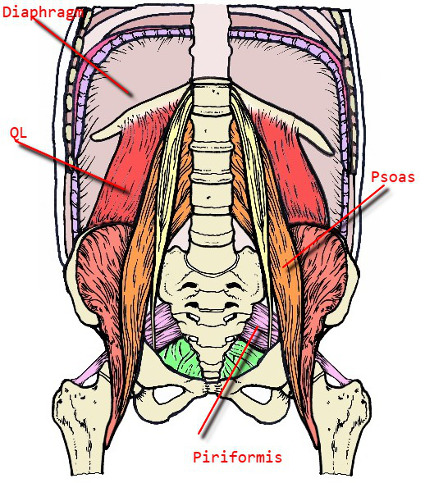
Let’s talk about the psoas muscle and how it affects back pain.
Stressing the psoas muscles, shown above, can contribute to back pain.
How does poor posture lead to spinal degeneration and back pain?
Poor posture and movement patterns lead to a great deal of back pain and spinal degeneration.
When we practice good posture the psoas, piriformis, and gluteus maximus perform a balancing act, keeping the spine balanced on top of the pelvis. The psoas, which straps the legs to the spine at the front of the body, acts like a pulley when it is well aligned and working well.
The psoas attaches at the back half of the body and moves forward to cross the pelvis. This creates the pulley action with the hip bone acting as the pulley and the psoas as the rope.
But this pulley action only happens when the legs are under the hips, which they rarely are. Most people stand and walk in a pattern that allows their legs to sink forward, taking the pelvis with them.
In this position the legs are rarely perpendicular to the ground.
To use a simple image, the legs are in the correct place when the seam of our pants hangs at a right angle to the floor. When this happens we get the pulley action of the psoas and the spine can transfer weight successfully from the head down to the pelvis and legs.
In this way, the bones and muscles work together to hold us up and the muscles are free to perform their role of moving us through space.
When the bones sink forward, the pelvis is misaligned and the curve of the lumbar spine becomes distorted—either flattening or arching too much. This forces muscles like the psoas and quadriceps to overwork to hold us upright because the misalignment of the bones disqualifies them from their essential function. This same type of posture also puts a great deal of strain on our ligaments, particularly the iliofemoral ligament that connects the femur bone to the hip bone.
This is a recipe for spinal degeneration and disaster, especially over the course of 60, 70, or 80 years. One of my main phrases is what you can get away with in your 20s, 30s, and 40s can come back to haunt you in your 60s, 70s and 80s.
A lot of cases of spinal degeneration—whether stenosis, degenerative disc disease, spondylosis, etc.—occur due to a lifetime of poor posture and movement patterns, often exacerbated by accidents and injuries.
Very often this poor posture is manifested by tucking the pelvis or letting the thighs lean forward, pulling the pelvis out of position.
Again, while many people can get away with poor posture for a lifetime, many cannot—especially those without good muscle tone.
What is a tip for people to make their psoas muscles healthier?
Take pictures of yourself from the side or look in a mirror and see if your legs are at a right angle to the floor (wear pants with a seam to make it easier to see). I work with a lot of people and very few have their legs under their hips.
Now, adjust your posture so that the seam of your pants are perpendicular to the floor, and your psoas will thank you. Work to maintain this posture, and you will likely see a decrease in the incidence of back pain.
Of course, fixing your posture isn’t a cure-all, but it is an excellent first step to finding temporary and ultimately/possibly permanent relief.
